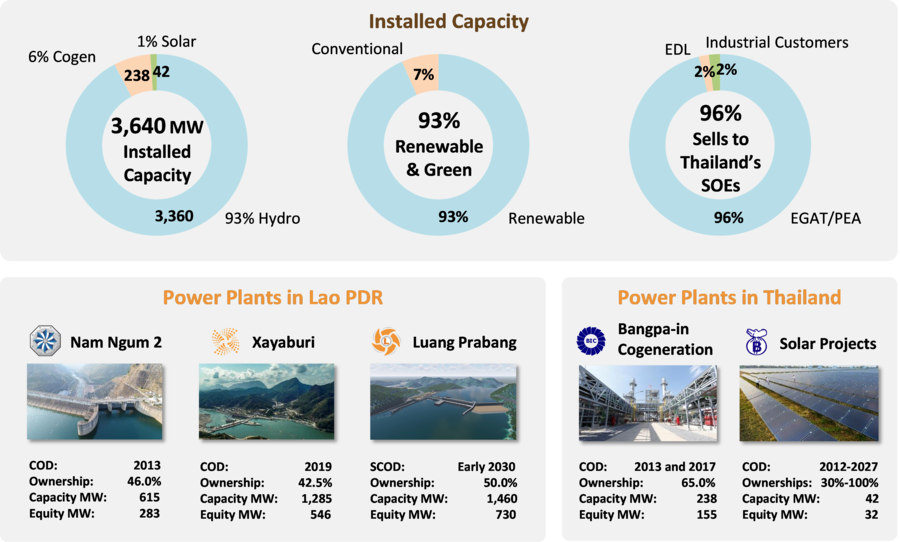FAQ
- Hydroelectric power plants with total installed capacity of 3,360 megawatt
- Cogeneration power plants with total installed capacity of 238 megawatt
- Solar power plants with total installed capacity of 42 megawatt

Click here for more information about CKPower’s power plants.
Storage Dam impounds water in a reservoir constructed higher than the powerhouse and uses the water pressure from the height difference of water levels between the reservoir and the powerhouse to spin the turbine with high velocity to generate electricity. The water in the reservoir can be stored and used in electricity production later throughout the year. Nam Ngum 2 Hydroelectric Power Plant is a storage dam hydroelectric power plant of CKPower.
Run-of-River hydroelectric power plant operates on the river without water storage capacity or water diversion, where the water intake volume is equal to the water outflow volume at all time. This type of hydroelectric power plant does not alter natural flow of the river and requires relatively low height difference between upstream and downstream water levels. The water will flow through the turbines and cause the blades to spin at a relatively low rotational speed to generate electricity. Xayaburi Hydroelectric Power Plant is a run-of-river hydroelectric power plant of CKPower.
35% of total water flow in the Mekong River is contributed from Lao PDR through natural rainfalls and side flows from small rivers within Lao PDR, while 16% of total water flow is contributed from China.
| China | Myanmar | Lao PDR | Thailand | Cambodia | Vietnam | Total | |
|---|---|---|---|---|---|---|---|
| Catchment Area (%) | 21 | 3 | 25 | 23 | 20 | 8 | 100 |
| Water Flow (%) | 16 | 2 | 35 | 18 | 18 | 11 | 100 |
Source: Overview of the Hydrology of the Mekong Basin, Mekong River Commission – November 2005
Storage dams in China have been built mainly to generate electricity, where the dams will store part of the water during the rainy season and release the stored water during the dry season, enabling the dams to generate electricity throughout the year. The storage of water during the rainy season to be used during the dry season in upper Mekong River in China has resulted in lower volatility of water levels in the lower Mekong River.
CKPower focuses on investing in clean and environmentally friendly energy projects, which have a stable cash flow and a power purchasing agreement with reliable off-takers. Depending on the energy types, CKPower requires a rate of return of 10-15% for a Green Field Project and 7-10% on a Brown Field Project.
CKPower has a policy to pay dividend not less than 40% of the net profit of separate financial statements after deduction of corporate income tax and legal reserve. Dividend payment will depend on the Company’s cash flows, investment plan, obligations under the conditions of loan agreements, and other relevant factors. In the past, the dividend payments were typically higher than the policy level. For more information about dividend payment, click here.
The Company discloses all debentures information in the Investor Relations section on website, which consist of:
- CK Power Public Company Limited (CKP)’s debentures information, Click here
- Nam Ngum2 Power Company Limited (NN2)’s debentures information, Click here
- Xayaburi Power Company Limited (XPCL)’s debentures information, Click here
CKPower strives to become one of the region’s largest producers of electricity from renewables with one of the lowest carbon footprints with an effort to achieve net-zero greenhouse gas emissions by 2050. The Company targets to increase the proportion of renewable energy to be at least 95% of its installed capacity by 2043. The new installed capacity will be renewables in Thailand and ASEAN, namely, hydro power, solar power and wind power.